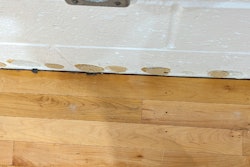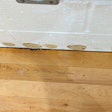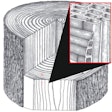
When doing a solid wood flooring installation, it's absolutely critical to know your "baseline moisture content," which is the target MC your wood flooring should have at the time of installation. How do you know what it is? Before we get to that, some fundamental wood facts are important.
First: wood is hygroscopic
The first thing we must understand is wood is, even when cut and dried, a reactive material—it is hygroscopic. It will take on moisture or lose moisture regardless of use, whether it is a solid or engineered wood floor, cabinetry, millwork, etc. Anyone who works with wood must understand its dimensional change coefficient (see the article "Understand Wood Floor Moisture Content & Dimensional Change" from the December 2014/January 2015 issue) and how the wood will react to the environment it is placed in. Whether you are a violin maker, a wood flooring professional or a restoration professional, it's vitally important to the success of the project you are working on. If you decide to shoot from the hip instead, and the job is big enough, you could put your entire company's existence at risk (believe me, unfortunately, I've inspected plenty of those jobs).
To get your baseline MC, first you must figure out what the environmental conditions will be year-round where the product is installed (this helps you predict how much moisture your wood floor will gain and lose). A controlled residential environment usually has a relative humidity fluctuation of 20%, and an uncontrolled residential environment may have a much broader range. Commercial locations may typically have a variance ranging from 30–35%.
When the wood stops gaining or losing moisture, we say the wood has reached its equilibrium moisture content (EMC). The midpoint between the extremes of the wood's EMC for the year is its baseline MC.
How to calculate it
Here's an example of how to calculate the baseline MC by dividing the high season and low season:
If your region has an expected EMC from a low of 6% to a high of 9%, the baseline MC of the wood flooring being installed would be 7.5%. If wood flooring is delivered and a moisture test finds it is at the desired baseline MC, if proper RH is maintained, no acclimation may be required. However, acclimation is often required to get the desired MC of the wood.
RELATED: How to Prevent Wood Floor Gaps in Winter
If the MC of the product received is well outside of the range of optimal MC, it will be very difficult to acclimate the product properly without substantial dimensional change, distortion and structural damage. For example, if the MC of the delivered wood is 12% and the optimal MC is 6%, excessive shrinkage, bowing, cupping and other physical anomalies would be expected during the acclimation process. The wood flooring should not be accepted.
What's acceptable?
So what does that mean to us as flooring installers? If we buy wood flooring measuring at the baseline MC in the above example (7.5%), the wood will only swell 1 to 1.5% during high RH season and shrink only 1 to 1.5% during low season—meaning minimal wood movement during seasonal swings.
But say we buy wood flooring at 6% MC during the winter season (its driest point) and need to get it to 7.5% baseline before installation. It may take six months to acclimate if no supplemental humidification is in place. If the solid wood flooring is installed at the 6% MC during the heating season and goes to 9% MC, the floor will most likely cup every humid season. If the same wood floor were installed at baseline (7.5%), the floor would probably experience acceptable subtle cupping for wider floors.
For the same reason, if the floor is installed at baseline, during the next heating season, acceptable minimal gapping would be experienced between the planks.
If you live in Dallas, your controlled RH may be 40–60%, whereas Denver may be 20–40% RH. The baseline MC of the solid wood you select will need to be adjusted prior to installation. For that reason, many times it's better to buy flooring that's made for your market and may be at baseline with little to no acclimation time required. It may cost you more upfront for materials but save you weeks or even months of acclimation time in the end.
RELATED: Understand Wood Floor Moisture Content & Dimensional Change

































